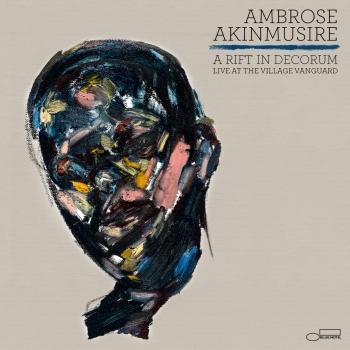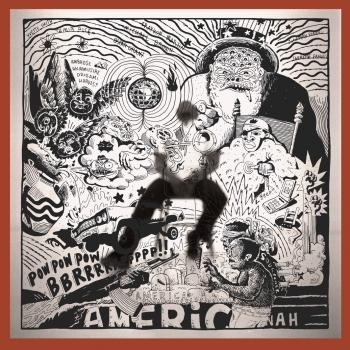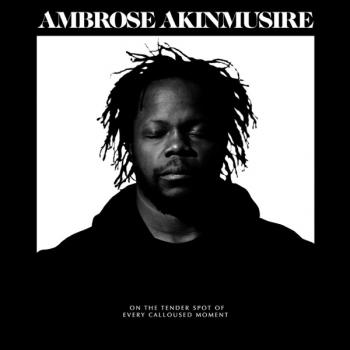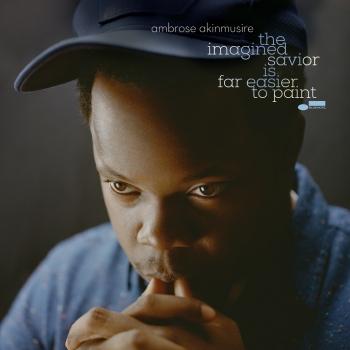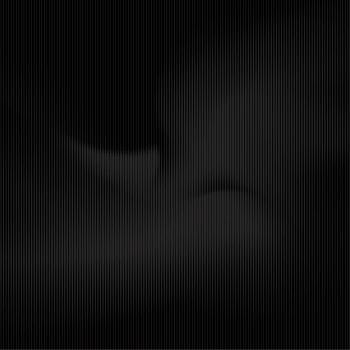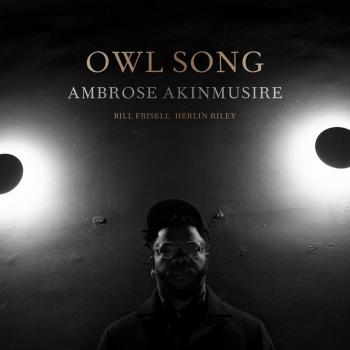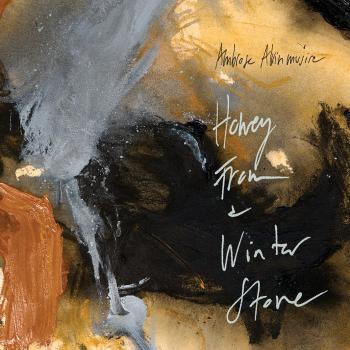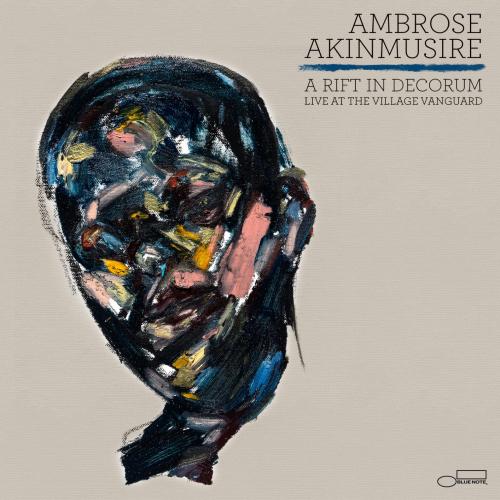
A Rift In Decorum: Live At The Village Vanguard Ambrose Akinmusire
Album info
Album-Release:
2017
HRA-Release:
09.06.2017
Album including Album cover
I`m sorry!
Dear HIGHRESAUDIO Visitor,
due to territorial constraints and also different releases dates in each country you currently can`t purchase this album. We are updating our release dates twice a week. So, please feel free to check from time-to-time, if the album is available for your country.
We suggest, that you bookmark the album and use our Short List function.
Thank you for your understanding and patience.
Yours sincerely, HIGHRESAUDIO
- 1 Maurice & Michael (sorry i didn't say hello) (Live) 12:28
- 2 Response (Live) 05:38
- 3 Moment in between the rest (to curve an ache) (Live) 09:44
- 4 Brooklyn (ODB) (Live) 09:44
- 5 A song to exhale (diver song) (Live) 06:40
- 6 Purple (Intermezzo) (Live) 02:01
- 7 Trumpet Sketch (milky pete) (Live) 14:21
- 8 Taymoor's World (Live) 10:29
- 9 First Page (Shabnam's poem) (Live) 07:46
- 10 H.A.M.S (in the spirit of honesty) (Live) 05:10
- 11 Piano Sketch (Sam intro) (Live) 03:31
- 12 Piano Sketch (beyond enclosure) (Live) 04:47
- 13 Condor (Harish intro) (Live) 02:15
- 14 Condor (Live) 05:46
- 15 Withered (Live) 08:26
- 16 Umteyo (Live) 07:38
Info for A Rift In Decorum: Live At The Village Vanguard
Hailed by NPR Music as “one of the most talked-about names in contemporary jazz,” 35-year-old trumpeter Ambrose Akinmusire has proven himself an artist of rare ability and wide-ranging aesthetic interests on his previous Blue Note albums When the Heart Emerges Glistening (2011) and the imagined savior is far easier to paint (2014). With his expansive new double-album A Rift in Decorum: Live at the Village Vanguard, Akinmusire reaches a new pinnacle: he and his longtime bandmates Sam Harris (piano), Harish Raghavan (bass) and Justin Brown (drums) join a distinguished strata of jazz artists who’ve made live recordings in the hallowed New York City venue.
“Justin and I have talked a lot about the spirits that we can feel in the Vanguard,” Akinmusire marvels. “It’s like I’m being bear-hugged by the spirits in there. Even just the people who showed up: Lee Konitz came down during the week, Billy Hart came down. Especially in a time like now, it’s great to have a place that still exists in the way that it originally existed.”
Akinmusire has worked more typically in a quintet setting with tenor saxophonist Walter Smith III by his side, but A Rift in Decorum finds him opting for the sparser texture and turn-on-a-dime execution of a quartet. “In history we don’t see too many trumpet quartets,” the leader says. “I think a lot of trumpet players shy away from it. I was into the challenge. When it’s just quartet I’m a little bit more free to express all of my influences.”
About the album title, Akinmusire muses: “A ‘rift’ to me relates to investigating a single moment. I think rifts are what make things beautiful. ‘Decorum’ ties into my feelings about what’s going on these days, musically and in the world. But there’s also something about the red curtains at the Vanguard: somehow in connection with that visual image A Rift in Decorum makes sense to me. Musically, I would add, the title is about celebrating the negatives and the positives, the ugly parts as well as the beautiful parts.”
How do these rifts manifest in the music? “I’ve been really into exploring extremes,” the trumpeter explains. “I take things that are really in your face and things that are so not in your face, and then it’s about rubbing those things together and hinting about a middle, or even questioning what a middle is. That’s what this quartet is about in my mind. So you’ll have a tune where we’re playing a lot of material, and then you’ll have something that’s much more spare, almost Morton Feldmanesque, or like a Chopin Nocturne. I think more and more I’m like this as a person — extremes, polar opposites, the far reaches of both.”
Akinmusire’s bandmates, uniquely attuned to his musical instincts and goals, bring those extremes into vivid relief, from the rapid-fire intricacy of “Brooklyn (ODB),” “Trumpet Sketch (milky pete)” and “H.A.M.S.” (short for “hard-ass m-f’ing song”) to the prevailing calm of “A song to exhale to (diver song),” or the solemn lyricism and bass-drone harmony of “Withered.” The longest bond in the band is between Akinmusire and Justin Brown: “We’ve been playing together as long as I’ve been playing jazz. I met Justin when I was 14 or 15 years old. There’s a long history of trumpet and drums together, so it’s been great to grow up and develop with a drummer as fantastic as him.”
Akinmusire met Harris and Raghavan around the same time in the mid-’00s. “Sam and I went to Manhattan School of Music together. Every time I heard him he would sound completely different. He checks out a lot of contemporary art, classical music, all kinds of things, and I think that really helps when I’m bringing in compositions. He’s so curious and he’s always studying. Harish and I met when I was at the Thelonious Monk Institute. He’s the instigator of the band: from the moment we start he’s already on a whole different path. When we do master classes I say that Harish approaches this music as some modern form of Dixieland or something — he’s improvising and thinking about melody and many times coming out of his register.”
The music’s harmonic advancement and dark mysterious moods come across with particular beauty and power on the Vanguard bandstand. The expressionistic effects that Akinmusire wrings from his horn — half-valve and non-pitch sounds, breath sounds, all part of the “extremes” he mentions above — root him in a trumpet legacy that extends beyond the expected post-bop influences to include early jazz as well as the avant-garde.
There’s a poignant story behind the opener, “Maurice and Michael (sorry I didn’t say hello)”: “I wrote it when I was artist-in-residence at the Monterey Jazz Festival. The place where you stay to compose is so beautiful. You’re by yourself overlooking the ocean, and if you look over to the right when it’s clear you can see San Francisco and Oakland. One day it hit me — wow, I have friends that are still over there in the hood who would never even know anything like this exists, so close by. Not long after that, I was on the BART home and I saw someone I grew up with named Maurice, who had a brother named Michael. I hadn’t seen them since high school. Maurice seemed to be on something, his eyes were red, he could barely walk, and I just couldn’t say hello. Here I am in some fancy suit with my expensive headphones and Moscot glasses, and this guy I grew up with looks like he’s homeless. It really affected me. I went through so many thoughts: ‘Do I think that I’m better?’ ‘Who am I to feel ashamed at whatever success I think I have?’”
The other titles are similarly evocative: The “enclosure” in “Piano Sketch (beyond enclosure)” refers to the fact that the music is written without bar lines. “Diver song” is the composer imagining “a diver with scuba equipment going down really slowly — this is kind of the soundtrack to that.” “A moment in between the rest (to curve an ache)” deals with “right when something stops, that moment right after. It’s like if you have two moments and right in between the moments you pause, that’s what that song would be. Having an ache, then stopping it and curving it — imagine that was a sound. That’s what this song is about.”
One could reasonably ask if the band felt pressure that week at the Vanguard, following in the footsteps of such giants. “I don’t feel pressure when I’m playing with my band,” Akinmusire responds. “Maybe it has something to do with me not living in New York, feeling more like a normal person, just a regular guy who plays trumpet. And also the older I get, the more of a spiritual thing it becomes for me. I really believe more than ever that I’m not the one playing, so the pressure is kinda off me. My job is to do all the work necessary to allow the spirit to come through me.”
Ambrose Akinmusire, trumpet
Sam Harris, piano
Harish Raghavan, double bass
Justin Brown, drums
Ambrose Akinmusire
“a thrilling young trumpeter and astute bandleader [with a] unique spark in his playing” (The New Yorker), brings his artistic vision to the next level with "The Imagined Savior Is Far Easier To Paint", his second release for Blue Note Records. The album follows his acclaimed major label debut "When the Heart Emerges Glistening", which New York Times critic Nate Chinen named his #1 album of 2011, Akinmusire takes a more compositional turn on "The Imagined Savior Is Far Easier To Paint", writing 12 of the 13 tracks and producing the album himself.
While Akinmusire continues to feature his extraordinary working quintet with tenor saxophonist Walter Smith III, pianist Sam Harris, bassistHarish Raghavan, and drummer Justin Brown, he also broadens his palette by enlisting guitarist and fellow Northern California native Charles Altura. In addition, Akinmusire unveils gripping new collaborations with the OSSO String Quartet and flutist Elena Penderhughes, as well as vocalists Becca Stevens, Theo Bleckmann, and Cold Specks.
However, these encounters with strings and voices don’t at all diminish the central role of Akinmusire’s quintet, now edging toward a sextet with the addition of Altura. It’s awe-inspiring to hear the band’s energy and focus as it confronts every challenge in “As We Fight (willie penrose),” “Vartha,” “Bubbles (john william sublett)” (inspired by tap-dance legend John Bubbles), and “Richard (conduit),” a 16-minute-plus closing epic recorded live at Jazz Standard in New York City.
Also, while Akinmusire’s virtuoso trumpet is still very present on "The Imagined Savior Is Far Easier To Paint", it coexists in a larger sonic framework than before. “Composition is what I’ve been focusing on the last few years,” the trumpeter says. “I want to be able to write a song and not have it need improvisation”
Reflecting on his penchant for long and poetic album titles, Akinmusire comments: “I don’t think I’ve been able to make an album yet where one word can capture the whole vibe. Maybe eventually I will. Right now I’m drawing from so many different parts of myself, and things that are outside of myself, that it’s hard to just have one word that says, ‘This means this.’”
Akinmusire continues: “The last album was about me — about things that I was experiencing and trying to change or accept about myself. The inspiration for this album is things outside of myself: people that I know, documentaries that I’ve watched, characters that I’ve made up.” Indeed, many song titles on "The Imagined Savior Is Far Easier To Paint" have a name attached in parentheses, and some of these reflect Akinmusire’s practice of creating elaborate storylines and fictional characters as an inspiration for his writing. On "The Imagined Savior Is Far Easier To Paint" he took this in a new direction, giving each of his guest vocalists a sketch of an idea and allowing them to create their own lyrics based on that idea.
The results are astonishing, beginning with Becca Stevens’ performance on her original “Our Basement (ed)”: centered by a pulsing heartbeat of a tempo, Stevens’ words and eerie unfolding harmonies mesh with Akinmusire’s quintet and the Osso String Quartet together in a complex and beautiful arrangement. The lyrical inspiration is “ed,” a homeless man on Akinmusire’s block who managed to save a couple hundred dollars to give back to the church that feeds him on weekends.
Theo Bleckmann, without question an innovator in vocal performance, met Akinmusire at the famed music workshop in Banff, Alberta. “We were on faculty and we played a Kate Bush song,” Akinmusire recalls. “After we played we looked at each other and I was like, ‘Ok, we have to work together.’” The resulting “asiam (joan),” featuring Bleckmann with the quintet, is inspired by Joni Mitchell — specifically, Michelle Mercer’s portrait of “Joan” in her 2009 book Will You Take Me As I Am: Joni Mitchell’s Blue Period.
“Ceaseless Inexhaustible Child (cyntoia brown)” — dedicated to the imprisoned young woman at the heart of the documentary The 16-Year-Old Killer — features the dramatic “doom soul” vocals of Cold Specks, the Canadian-born, London-based singer-songwriter. “I’m a huge fan of hers,” says Akinmusire. “In June I did this tribute to Joni up in Toronto. I wrote [Cold Specks] an email asking her to be on my album, and she wrote back saying she was just about to invite me to be on her album.”
Along with the vocal tracks, there are two additional pieces with string quartet and flute, “The Beauty of Dissolving Portraits” and “inflatedbyspinning.” The former stems from Akinmusire’s influences outside of jazz: “I’m really into people like Arvo Pärt, people whose compositions tend to evolve slowly. They’re adding and taking things away in a way that you don’t notice until a certain amount of time has gone by. It’s really hard with jazz instrumentation in a quintet format to get that sort of sustain.”
With “inflatedbyspinning,” Akinmusire captures a daydream: “I had an image of women standing on a cliff spinning. One was holding a red balloon, and at the start of the spinning the balloon wasn’t inflated, but when the spinning stopped, it was inflated.” Raghavan’s broad-toned arco bass supplements the strings and flute here.
In a loose parallel to “my name is OSCAR” (dedicated to the late Oscar Grant) on his previous album, Akinmusire offers “Rollcall for Those Absent” as an overt statement on “a certain reality that you can't deny that goes on here in America and in the world: this fear of black men that causes a lot of sad stories.” The instrumentation here is wholly different from the rest of the album: Harris plays the melody on mellotron while Akinmusire plays chords and bass notes on Juno synth, and Muna Blake (the young daughter of drummer Johnathan Blake) reads aloud the names of numerous people killed by police — or by vigilante action, as in the prominent case of Trayvon Martin. “Having a young voice read the names, it’s like the beginning of life talking about the end of life,” Akinmusire says. “I wanted to capture that. In the same way, sounds that are really high and really low are like the beginning and the end.”
Born and raised in Oakland, California, Ambrose Akinmusire (pronounced ah-kin-MOO-sir-ee) was a member of the Berkeley High School Jazz Ensemble when he caught the attention of saxophonist Steve Coleman. Akinmusire was asked to join Coleman’s Five Elements, embarking on a European tour when he was just a 19-year-old student at the Manhattan School of Music. After returning to the West Coast to pursue a master’s degree at the University of Southern California, Akinmusire went on to attend the Thelonious Monk Institute of Jazz in Los Angeles, where he studied with Herbie Hancock, Wayne Shorter and Terence Blanchard.
In 2007 Akinmusire won the prestigious Thelonious Monk International Jazz Competition, decided by a panel of judges that included Blanchard, Quincy Jones, Herb Alpert, Hugh Masekela, Clark Terry and Roy Hargrove. That year Akinmusire also won the Carmine Caruso International Jazz Trumpet Solo Competition and released his debut album Prelude…To Cora on the Fresh Sound label. He moved back to New York and began performing with the likes of Vijay Iyer, Aaron Parks, Esperanza Spalding and Jason Moran. It was also during this time that he first caught the attention of another discerning listener, Bruce Lundvall, President of Blue Note Records.
Akinmusire’s Blue Note debut "When The Heart Emerges Glistening" was released in 2011 to rave reviews. The Los Angeles Times praised his “chameleonic tone that can sigh, flutter or soar,” adding that “Akinmusire sounds less like a rising star than one that was already at great heights and just waiting to be discovered.” DownBeat described his playing as “spectacular and not at all shy — muscular, driving, with a forward sound, pliant phrasing and a penchant for intervallic leaps,” concluding that “clearly something very special and personal is at work here, a vision of jazz that’s bigger than camps, broader and more intellectually restless than blowing sessions.”
This album contains no booklet.










